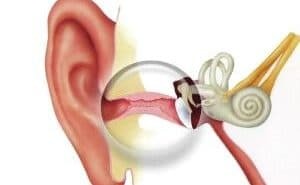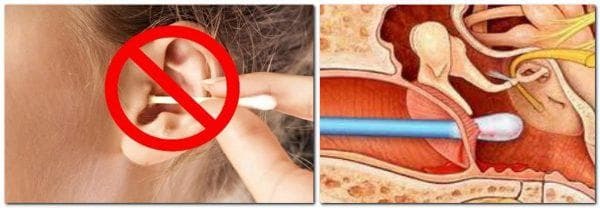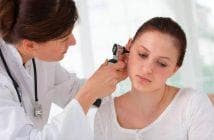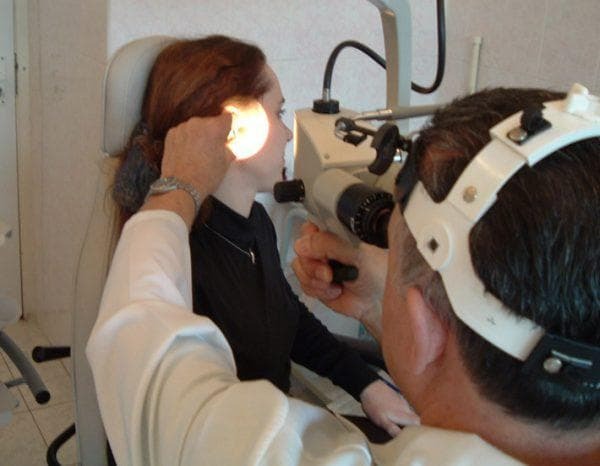
The tympanic membrane is a 0.1 mm oval-shaped membrane that separates the ear canal and the middle ear. It transmits vibrations of air( sounds) to the adjoining malleus( auditory ossicle), further vibrations are transmitted to the inner ear. In case of damage to the tympanic membrane, vibration is disturbed and hearing deteriorates.
Contents
- 1 Why is the membrane bursting in the ear?
- 1.1 Characteristic trauma symptoms
- 1.2 What does the gap mean?
- 2 What to expect at reception
- 3 Methods of treatment
- 4 Prophylaxis of damages
Why is the membrane bursting in the ear?
The most common causes of rupture of the membrane:
- Inflammatory diseases. When otitis in the middle ear accumulates fluid or pus. In a large amount of content is pressing on the eardrum. That begins to rot and thin out, in the end, there is a breakthrough. Pus follows, the patient feels relieved. But the integrity of the membrane is broken, as is its function to delay the entry of harmful microbes into the middle and lower ear.

Burst of the eardrum
- Exposure of pressure from the outside .The phenomenon is also called an acoustic trauma or barotrauma. This happens when changing the pressure in an air flight, with a sharp application and pulling the palm of your hand away from the ear. The eardrums burst when they sneeze, closing their noses when they plunge abruptly into the water. In all these cases, the membrane is subjected to excessive pressure, under the influence of which it is torn.
- Noise trauma. From loud sounds, explosions, eardrums are also torn. Thus the person starts to hear worse, constantly rustles in ears.
- Mechanical injury by foreign object. For example, when the ear canal is cleaned deeply, using matches, pins. In fact, you can damage your membrane with a cotton swab, if you do not calculate the pressure or make a sharp move.
- Thermal burns .This happens at metallurgical enterprises.
The video effects of a ruptured eardrum:
Characteristic symptoms of injury
When a ruptured eardrum breaks, a person feels a sharp pain. It happens before darkening in the eyes and up to the state of shock. Gradually, the pain subsides and other symptoms are revealed that indicate a ruptured eardrum:
- worsens hearing;
- is noisy. The noise can be increasing, becoming stronger;
- not passing sense of ear congestion;
- when blowing it seems that the air comes out from the depth of the ear;
- blood from the ear is a sign of serious damage to internal tissues.
With an average otitis, when severe pain suddenly ceases, this indicates a rupture of the membrane. In addition, pus or clear liquid flows from the ear.
What threatens the gap?
The consequences of a rupture of the ear can directly depend on how quickly a person turned to the doctor and taken measures for timely treatment.
Usually, hearing impairment is observed with trauma. It will recover when the damage heals. The timing of the healing depends on the size of the gap.

Traumatic rupture of the eardrum
The more it is, the longer it will heal. Hearing impairment is influenced by the location of the hole formed.
Completely hearing is unlikely to recover if the structure of the middle and inner ear is damaged.
Infection in the middle ear can lead to inflammation, to the development of a chronic disease( chronic otitis media).
The main danger of a rupture of the membrane is the absence of obstruction for microorganisms and infections, their entry into the middle ear. So, the risk of inflammation, neuritis, otitis, even meningitis and encephalitis increases!
In case of sharp pain in both ears or in one, which has been replaced by a decrease in hearing, you should consult a doctor. Because the rupture of the tympanic membrane threatens to get the infection into the inner ear. Because of this, serious problems can arise.
What to expect at the reception
To ascertain the trauma can a trauma doctor, and treat it - specialization of the otolaryngologist.
Evaluation of damage is possible only with the use of a medical device( otoscope). The doctor inserts an ear mirror into the passage, directs the light at the desired angle, the auricle pulls back and forth to examine the eardrum well. This determines the extent of its damage, the presence of pus or blood in the ear. 
If such an inspection is not enough, another survey is conducted - audiometry. With the help of special equipment, the presence of damage to the membrane, its degree, as well as how much the patient's hearing has worsened.
Additionally, the liquid is taken from the ear for analysis. It is important to analyze its composition for the presence of bacteria and pathogenic microbes.
 And here's what to do if the ear has blown out and what means it is worth using.will help to understand this article.
And here's what to do if the ear has blown out and what means it is worth using.will help to understand this article.
Than to treat if the ear has blown and what means the most effective, will help to understand this article.
It will also be interesting to know whether it is possible to heat the ear with purulent otitis: http: //prolor.ru/u/ lechenie-u / mozhno-li-gret-uxo-pri-otite.html
Perhaps you will also be interested in knowing what to do with inhalationdry cough nebulizer.
Treatment methods
Treatment of rupture of the tympanic membrane depends on the degree of damage to it.
The doctor at the first examination will clean the wound of dirt, dust, blood clots, treat the wound with a special solution( silver nitrate or chromic acid), and the cavity of the ear canal - alcohol. Also at the reception the doctor will determine how much the patient's hearing worsened. At the end of the procedure, the doctor will close the ear canal with a cotton swab. Can recommend ear drops-antibiotics to eliminate pathogenic microflora.
If the membrane is not slightly damaged, the rupture will heal independently. The patient only needs to leave his ears alone, do not conduct any manipulations in the aisles himself.
With a small gap, the doctor applies a patch made of thin paper, changes it several times( usually three to four times is enough).Such procedures will accelerate healing and virtually exclude infection in the middle ear.
With strong ruptures, membranes are resorted to the surgical method of membrane repair - myringoplasty.

Procedure for myringoplasty
The operation is performed using general anesthesia. The essence of surgical intervention is to restore the tympanic membrane by patching it.
A piece of tissue to cover the damage is cut behind the patient's ear( a small incision is sufficient).
The operation is performed with the endoscope. Self-absorbable materials attach a shred to the damaged partition. After the operation, the ear canal is closed with a cotton swab impregnated with an antibiotic so that the infection does not get into the wound.
To the operated patient several hours are forbidden to do through the nose deep sharp inhalations and exhalations, blow your nose so that the patch does not move from the right place. The fact is that the holes of the auditory tubes go into the nasopharynx. Sharp breaths and exhalations through the nose make the eardrum move, which is fraught with the displacement of the patch.
The gap is completely overgrown in about two weeks.
And that's why the ear is scratched internally and by what means you can help yourself at home, is described in this article.
It will also be interesting to know how to drop drips into your ear yourself.
And here what child's drops in the ear with pain should be used in the first place, is described in this article.
For those who want to know what drops in the ear are used in otitis and what their name is, is described in detail in this article.
And here is it possible to warm your ear with tubo-otitis and how to do it correctly, is described in this article.
Damage prevention

To preserve the integrity of the eardrums is most often possible if to adhere to simple measures:
- During the exacerbation of ENT disease, one should refrain from air travel.
- Do not clean the ear passages too deeply. It is strictly forbidden to clean your ears with matches and other sharp objects. Correctly - to clean from sulfur only the auricle, not penetrating deep into the ear canal.
- Treat otitis in time. At the first signs( constant blunt pain, noise in the ears, hearing loss) to consult a specialist, avoid self-treatment.
- Beware of strong noise. Stay away from yelling speakers, sound amplifiers, cover your ears with the expected claps.
- During flights during takeoff and landing it is recommended to swallow more often. So the pressure levels up. Candies or gum is used.
Timely address to the doctor otolaryngologist guarantees healing of the rupture of the tympanic membrane without complications.
